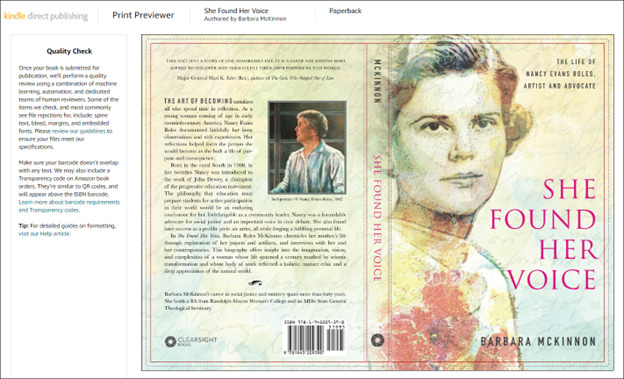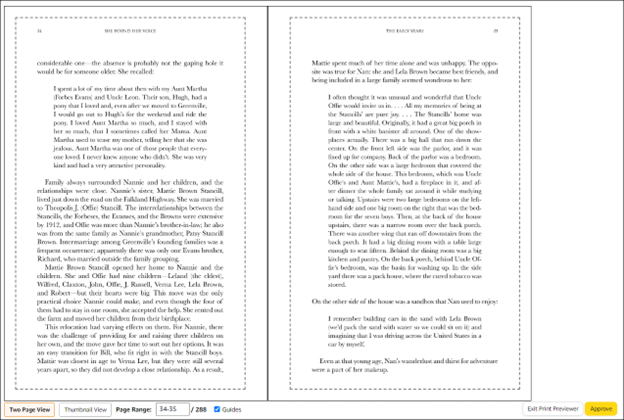
Our client was nervous. With a big book launch event coming up, she was stuck in limbo on the self-publishing platform, waiting for “account approval.” Until then, she was unable to set up her book and order copies of it. After a week of waiting, and with negligible customer support available, “nervous” would soon turn into “frantic.”
In fact, we still had a fair amount of time, but the tighter the timeline gets, the higher the level of stress you are likely to feel about your book project.
The lesson: Build slack into your book’s project plan.
What is slack?
Slack is the amount of time you have in your project plan to complete a task before it delays other tasks.
Another way to look at it: slack is the “extra” time you build into your project plan for the unexpected so that you can still meet your target date.
In the case of our client, a book launch event was the target date. Before that event, we needed time to set up her account, upload all the book metadata and files, order proofs, review and correct any issues, approve for publication, and order books. The slack was the cushion time we had to get the account working before it would be too late to get books in time for the event.
Why you need slack
Slack is a core project management concept (not just for book projects). You need it because projects—and humans—are unpredictable. If you expect everything to run perfectly and you design your timeline that way—with no slack in it—when something goes off the rails, you will likely miss your deadline.
By building in slack, you can mitigate risk, alleviate anxiety, and have a greater chance of hitting your target dates.
Where you need slack in book projects
In book projects, there are two major types of slack needed: creative slack and production slack.
Creative slack
The creative process—writing, revision, editing—is inherently unpredictable. Even on books that are relatively straightforward to write, inevitably something surprises you. (This is a good thing!) And while focused deadlines can be beneficial, breathing space—problem-solving space, discovery space, innovation space—is usually needed as well.
For more on the creative process, and why you need time for it, I invite you to read about self-contained vs. emergent writing, how long the writing process should take, and revision. The rest of this article will focus on production slack.
Production slack
The type of time crunch our client felt is related to the publishing of the book—that is, production. While the print-on-demand process is well defined at a high level, there are unpredictable elements to it. Dealing with uncooperative systems, a long printing queue, or shipping delays . . . Building in extra time will help keep heartburn under control.
NOTE: I’m writing here about self-publishing, but the concept of slack applies to traditional publishing as well. Within the past few months, I know two traditionally published authors who experienced delays in getting pre-orders filled, i.e., books showed up late.
Common production delays—and tips to mitigate risk
Self-publishing authors usually work with one or both of the two major print-on-demand (POD) platforms: Kindle Direct Publishing (KDP) and IngramSpark (IS). While delays can occur on either platform, I find that IngramSpark is by far the most variable. Here are the main places you can get caught in delays.
Account setup (IS)
Before you can set up your book for publication, you must set up an author (or publisher) account that includes your tax information (tax ID, business type, etc.) and bank information (routing numbers, account number, etc.). Once you have an account, you can begin setting up your books.
Our client got caught in a loop:
Congratulations! You’ve fully set up your account! Now you can start publishing like a pro.
Oh the excitement! Here we go . . . uploading the book.
You cannot upload your book files until your account is set up. Please finish your account setup.
What? OK, let’s see what we missed. Click Account Setup . . .
Congratulations! Your account setup is 100% complete!
OK. Let’s try uploading again.
You cannot upload your book files until your account is set up. Please finish your account setup.
WHAT???
Apparently, in addition to the initial automated check, IngramSpark does some sort of manual check. This can cause delays—in this case longer than a week—and their messaging is poor (bad interface design), so it is hard to know what the problem is and why it is taking so long.
I have never seen this issue on KDP.
Mitigation: Set up your KDP and IS accounts well in advance of when you expect to set up your books and upload files.
File review (mostly IS)
When you upload files for print books, there is a review process to make sure the files meet technical specifications. This gives you a chance to correct any problems before proceeding.
KDP file review
On KDP, when you upload your files, you can preview them online immediately. KDP displays your cover with margins and crop marks so you can see if the spine text is centered correctly or if the trim will accidentally cut off text. Likewise, the interior is displayed as a spread (pages side-by-side) so you can see if you made any mistakes with left/right and even/odd pages, if the margins are off, or if there are other issues. The KDP system will also flag critical issues for you—resolution, images off the page, and so on.


If there are corrections needed, you can immediately exit the previewer, go fix the files, upload new ones, and check them again. And you can do this as many times as needed. Once you approve your book for publication, there is one last manual review process, which usually completes within 24 hours, at which point your book becomes available on Amazon.
IS file review
On IngramSpark, when you upload files, there is no online preview available. There is an automated check to make sure your metadata is correct and that the files pass the basic technical requirements. Assuming they do, the files then go through a manual checking process. This is where you can get delayed. Sometimes the manual check is fairly quick and takes only a day or two; sometimes it takes weeks.
When the manual review is done, you are emailed a link to a PDF proof to review. The PDF proof shows you the full cover, the front cover, the interior (one page at a time, not spreads) and the back cover. If the proof looks okay, you can approve and print. If there are issues, you have to make your corrections, upload fresh files, and go through the entire automated and manual review process all over again.
Compare this to the online review KDP gives you right up front—IngramSpark is way less efficient.
Mitigation: Because the IngramSpark process is the most time-consuming, do what you can to minimize the number of times you have to go through it.
- Set up KDP first. When publishing the same book on both KDP and IS (i.e., using the same interior file), set up your book on KDP first, get a print proof, and make all needed corrections. Then upload your book to IngramSpark. That way you know the interior text is good; you should not have to correct anything there. Cover color can be tetchier on IS, so even if your cover looks good on KDP, you may find some adjustments are needed on IS.
- Follow the IS technical specs. IngramSpark provides a detailed document of technical specifications. In the automated review process, IS will flag things like using RGB rather than CMYK color, low-resolution images, and missing fonts. Before you proceed to the manual review process, fix any flagged issues and upload fresh files.
Printing and shipping of author copies (mostly IS)
As an author, of course you want to keep some books on hand to sell or give away. On both KDP and IS you can order author copies basically at cost (plus shipping, etc.).
For author copies, both KDP and IS provide estimated printing times, which can vary depending on the time of year. Common times are 5 days for paperbacks and 10 days for hardbacks, but both can be longer or, if you are lucky, shorter. And both platforms usually give you a choice of shipping speed (faster equals higher price).
KDP author copies
KDP has only one printing option available for author copies, but in my experience, KDP is consistent in meeting or beating their predicted timeline.
When you order author copies from KDP, they are routed through your Amazon shopping cart. You cannot use Prime shipping on author copies, so you must pay for shipping. Sometimes there is only one shipping option; sometimes you get a choice of shipping speeds. I frequently find that KDP/Amazon packages arrive ahead of schedule, and all packages come with tracking.
IS author copies
IngramSpark usually offers three different printing speeds (at three different prices): economy, express, or rush. HOWEVER, there are times of year (holidays) when only the economy printing is available.
In my experience, when using the economy printing option, IngramSpark is entirely inconsistent and unpredictable in its performance. I once ordered copies of the exact same book to be shipped to three different addresses. All three orders were placed within a half hour of each other. One arrived within a week; another took about two weeks; the third sat in the print queue for several weeks. Why? WTH knows.
From what I can tell, IS printing performance seems to be somewhat correlated with the Ship To location. It’s possible they are routing orders to the print location closest to the shipping location, but if so, they seem to be doing it without any regard to existing queues, so if you are lucky and are routed to a short queue, you get your book fast; if you are unlucky, too bad, so sad.
If you choose express or rush printing, you will get much faster service.
IS offers a variety of shipping methods and speeds. The basic shipping does not come with tracking, so if you are watching closely for a package to arrive, be sure to choose one of the other options. IMO IngramSpark shipping rates are high, especially for small orders, and the expedited shipping rates are ridiculously high, so planning ahead can save money.
Mitigation: Allow plenty of time for your books to arrive before any events. I suggest 3-4 weeks if possible. Then be happy if your order shows up earlier than that. If you are in a serious time crunch, see the tips below.
Tips if you are in a time crunch
Let’s face it: sometimes we get off track, sometimes we miss deadlines, sometimes our planning is . . . lacking. If things get bogged down in production and you are desperate to have books for an event, have a backup plan. Here are some tips:
- Order paperbacks. Paperbacks typically print and ship faster than hardbacks. This is simply due to the more-complex construction process for hardbacks. Having only paperbacks is better than having no books at all.
- Choose expedited printing. On IngramSpark, you may be able to choose expedited printing for author copies (see above). (KDP does not offer different printing speeds.)
- Choose expedited shipping. On both KDP and IS, you may be able to choose expedited shipping for author copies.
- Order retail. Retail POD book orders print and ship faster than author copy orders (because there is more money to be made and customer satisfaction to account for). So if you get desperate, you can order your own book retail. Some authors temporarily lower the price first when they do this (so they pay less). Recall also that you will get paid a royalty from the sale, so you aren’t really paying full retail price. (Some small consolation.)
- Use ebooks as a backup. When you publish an ebook, it usually shows up as available for sale within about a day of uploading the files. No printing, no shipping needed. If there is no possibility of getting print books for your event, focus on your ebook. If your Kindle ebook is part of the KDP Select program, you could do a free day for your launch event. (Other ebook platforms may have options for promotions as well.)
When it comes to getting your books for an event, if you are crunched, you will likely have to make a tradeoff of some sort—the type of book available or the price you pay to get it and thus how much you make. But there is almost always some option.
Build in slack and relax
No doubt, your book project is going to cause you some stress, especially if it’s your first book and everything is new. But by building in slack, you will know you have enough time to successfully reach your launch—even when there are delays.
And if everything gets done a little earlier than the plan says, well, who’s going to complain about that?
If you love to figure things out, then you might enjoy DIYing your self-publishing. If you’d rather have professional help, get in touch at info@clearsightbooks.com.

